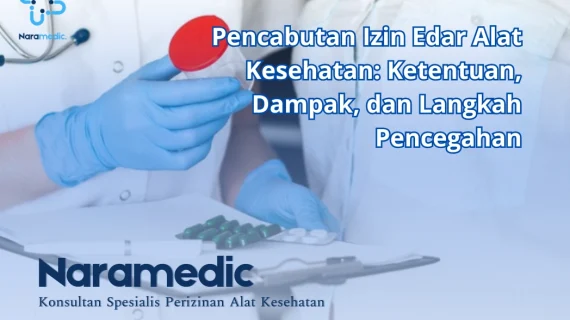Cara Validasi AKL (Alat Kesehatan Elektronik) dengan Mudah dan Cepat
AKL (Alat Kesehatan Legal) merupakan nomor registrasi resmi yang diterbitkan oleh Kementerian Kesehatan Republik Indonesia sebagai bukti bahwa suatu alat kesehatan telah melalui proses evaluasi dan memenuhi standar yang ditetapkan. Standar ini mencakup aspek keamanan, mutu, dan manfaat yang memastikan bahwa alat kesehatan tersebut aman untuk digunakan dan mampu memberikan fungsi sesuai yang diharapkan.

Sumber Gambar : Freepik
Proses registrasi ini melibatkan pengujian yang ketat serta pemeriksaan dokumen terkait, seperti sertifikasi produk, laporan uji laboratorium, dan kepatuhan terhadap regulasi internasional maupun nasional. Validasi AKL sangat penting untuk dilakukan, baik oleh produsen, distributor, maupun konsumen, guna memverifikasi legalitas produk sebelum digunakan atau dipasarkan di Indonesia.
Hal ini tidak hanya menjamin keamanan pengguna tetapi juga mendukung pengawasan peredaran alat kesehatan agar sesuai dengan ketentuan hukum yang berlaku. Produk tanpa AKL resmi berisiko tidak memenuhi standar, yang dapat berdampak negatif pada kesehatan masyarakat.Oleh karena itu, pengecekan AKL menjadi langkah krusial dalam memastikan bahwa alat kesehatan yang beredar di pasar Indonesia telah terjamin kualitasnya dan mematuhi aturan yang telah ditetapkan.
Mengapa Validasi AKL Penting?
1. Keamanan Pengguna
Salah satu alasan utama validasi AKL (Alat Kesehatan Legal) sangat penting adalah untuk memastikan keamanan pengguna. Produk yang terdaftar telah melalui serangkaian uji kelayakan dan evaluasi, termasuk pengujian teknis dan klinis, guna membuktikan bahwa alat kesehatan tersebut tidak menimbulkan risiko berbahaya bagi penggunanya. Dengan adanya AKL, konsumen dapat merasa lebih tenang karena produk yang mereka gunakan telah memenuhi standar keamanan yang ditetapkan oleh Kementerian Kesehatan Republik Indonesia. Tanpa AKL, tidak ada jaminan bahwa produk tersebut aman untuk digunakan, yang berpotensi menimbulkan efek samping atau risiko kesehatan.
2. Kepatuhan Hukum
Validasi AKL juga penting untuk memastikan kepatuhan terhadap hukum yang berlaku. Di Indonesia, peredaran alat kesehatan diatur secara ketat melalui regulasi yang bertujuan untuk melindungi masyarakat dari produk-produk yang tidak sesuai standar. Produk tanpa AKL resmi dianggap ilegal dan dapat dikenai berbagai sanksi, seperti denda, penarikan produk dari pasar, hingga ancaman pidana bagi produsen atau distributor yang melanggar. Dengan memastikan bahwa produk memiliki AKL, produsen dan distributor tidak hanya melindungi diri mereka dari konsekuensi hukum, tetapi juga menunjukkan komitmen mereka terhadap integritas bisnis yang sesuai dengan regulasi.
3. Kepercayaan Konsumen
AKL juga memiliki peran penting dalam membangun kepercayaan konsumen. Ketika suatu produk memiliki nomor registrasi AKL yang valid, konsumen lebih yakin terhadap kualitas, keamanan, dan manfaatnya. Kepercayaan ini menjadi modal penting bagi produsen dan distributor dalam membangun reputasi mereka di pasar. Sebaliknya, produk tanpa AKL dapat menimbulkan keraguan dan mengurangi kredibilitas di mata pembeli. Dalam industri alat kesehatan yang sangat mengutamakan kesehatan dan keselamatan, kepercayaan konsumen adalah kunci keberhasilan.
4. Mendukung Standar Mutu dan Persaingan Sehat
Validasi AKL juga berkontribusi pada terciptanya standar mutu yang tinggi di industri alat kesehatan. Dengan memastikan hanya produk-produk yang terdaftar dan memenuhi standar yang beredar di pasar, pemerintah membantu mendorong persaingan yang sehat di antara produsen. Hal ini tidak hanya bermanfaat bagi konsumen, tetapi juga bagi produsen yang ingin bersaing dengan menawarkan produk berkualitas tinggi.
5. Perlindungan Kesehatan Masyarakat
Terakhir, validasi AKL berfungsi sebagai upaya preventif untuk melindungi masyarakat dari risiko alat kesehatan yang tidak terstandar. Dengan adanya pengawasan dan validasi, produk-produk yang beredar di pasar dapat dipastikan aman digunakan untuk tujuan medis atau kesehatan, sehingga mengurangi potensi dampak negatif yang dapat membahayakan masyarakat luas.
Baca Juga Tentang : Cek AKL Kemenkes bersama Konsultan Jasa Izin Alkes Terbaik Naramedic!
Langkah-langkah Validasi AKL
1. Persiapkan Informasi Produk
Sebelum memulai validasi, pastikan Anda memiliki data berikut:
- Nama produk alat kesehatan.
- Nomor AKL yang tertera pada kemasan atau dokumen produk.
- Nama produsen atau distributor.
2. Kunjungi Website Resmi Kemenkes
- Akses Sistem Informasi Alat Kesehatan (SIAK Online) melalui perangkat Anda.
- Pilih menu “Pencarian Data Alat Kesehatan.”
3. Masukkan Informasi yang Dibutuhkan
- Input Nomor AKL pada kolom yang disediakan.
- Jika nomor AKL tidak diketahui, Anda dapat mencari menggunakan nama produk atau produsen.
4. Lakukan Pencarian
Klik tombol “Cari” untuk melihat hasil validasi. Sistem akan menampilkan informasi lengkap terkait produk, seperti:
- Status registrasi (aktif atau tidak).
- Masa berlaku nomor AKL.
- Nama produsen dan distributor resmi.
5. Verifikasi Informasi
Pastikan informasi yang ditampilkan sesuai dengan produk yang Anda miliki. Jika ada ketidaksesuaian, hubungi produsen atau distributor untuk klarifikasi.
Apa yang Harus Dilakukan Jika AKL Tidak Ditemukan?
Ketika nomor AKL (Alat Kesehatan Legal) sebuah produk tidak ditemukan dalam sistem atau database resmi, langkah-langkah tertentu perlu diambil untuk memastikan produk tersebut memenuhi standar keamanan dan legalitas. Berikut adalah panduan lengkap yang dapat dilakukan:
1. Periksa Nomor AKL Secara Teliti
Langkah pertama yang harus dilakukan adalah memastikan bahwa nomor AKL yang dimasukkan ke dalam sistem pencarian benar dan lengkap. Kesalahan kecil seperti salah ketik, angka yang terlewat, atau format yang tidak sesuai dapat menyebabkan hasil pencarian menunjukkan bahwa nomor AKL tidak ditemukan. Periksa kembali dokumen atau label produk untuk memastikan informasi yang dimasukkan sudah akurat. Jika tersedia, gunakan sistem pengecekan AKL resmi yang disediakan oleh Kementerian Kesehatan Republik Indonesia.
2. Verifikasi Dokumen Pendukung
Selain memeriksa nomor AKL, periksa juga dokumen pendukung lain yang biasanya menyertai produk alat kesehatan, seperti sertifikat registrasi, label, atau dokumen kepatuhan. Jika dokumen ini tidak tersedia atau mencurigakan, hal ini bisa menjadi indikasi bahwa produk tersebut belum melalui proses registrasi yang benar.
3. Hubungi Produsen atau Distributor
Jika nomor AKL tetap tidak ditemukan setelah pengecekan ulang, langkah berikutnya adalah menghubungi pihak produsen atau distributor produk. Tanyakan secara langsung apakah produk tersebut telah melalui proses registrasi di Kementerian Kesehatan. Produsen atau distributor yang bertanggung jawab seharusnya dapat memberikan penjelasan dan dokumen pendukung yang membuktikan legalitas produk. Jika mereka tidak dapat memberikan informasi yang memadai atau menolak memberikan bukti, hal ini bisa menjadi indikasi bahwa produk tersebut ilegal.
4. Cari Informasi di Platform Resmi
Kementerian Kesehatan Republik Indonesia menyediakan platform resmi untuk pengecekan alat kesehatan yang terdaftar. Gunakan layanan ini untuk mendapatkan informasi tambahan mengenai status produk. Pastikan Anda menggunakan sumber informasi yang terpercaya dan resmi untuk menghindari kesalahan atau informasi yang tidak valid.
5. Laporkan ke Kementerian Kesehatan
Jika semua upaya untuk memverifikasi legalitas produk tidak memberikan hasil memuaskan, langkah penting yang perlu diambil adalah melaporkan produk tersebut ke Kementerian Kesehatan Republik Indonesia. Laporan dapat dilakukan melalui kanal resmi seperti situs web, email pengaduan, atau hotline khusus yang disediakan oleh Kemenkes. Berikan informasi lengkap mengenai produk, termasuk nama, nomor seri, produsen, dan alasan mengapa Anda mencurigai produk tersebut tidak memiliki AKL yang sah. Laporan ini membantu pihak berwenang mengambil tindakan lebih lanjut, seperti investigasi dan penarikan produk dari pasar jika diperlukan.
6. Jangan Gunakan Produk Sebelum Ada Kepastian
Hindari menggunakan produk yang AKL-nya tidak ditemukan sampai Anda mendapatkan kepastian mengenai status legalitasnya. Menggunakan produk tanpa AKL yang jelas dapat menimbulkan risiko kesehatan yang serius karena produk tersebut mungkin tidak memenuhi standar keamanan dan mutu yang ditetapkan. Jika produk telah digunakan dan menimbulkan efek samping, segera konsultasikan dengan tenaga medis dan laporkan kejadian tersebut ke pihak berwenang.
7. Edukasi dan Sosialisasi
Sebagai konsumen yang peduli, Anda juga dapat membantu meningkatkan kesadaran masyarakat mengenai pentingnya AKL pada produk alat kesehatan. Edukasi ini dapat dilakukan dengan berbagi informasi mengenai cara mengecek AKL, risiko menggunakan produk tanpa AKL, dan langkah-langkah yang harus diambil jika menemukan produk mencurigakan.
8. Tinjau Alternatif Produk
Jika produk yang dicari ternyata tidak memiliki AKL yang valid, pertimbangkan untuk mencari alternatif produk lain yang telah terdaftar secara resmi. Pastikan untuk memilih produk yang berasal dari produsen terpercaya dan memiliki AKL yang jelas. Dengan begitu, Anda dapat menggunakan produk dengan rasa aman dan tanpa keraguan mengenai legalitasnya.
Baca Juga Tentang : AKL dan AKD adalah Izin Edar yang Krusial, Pelajari di Sini!
Tips Penting dalam Validasi AKL
Memastikan legalitas alat kesehatan melalui validasi AKL (Alat Kesehatan Legal) adalah langkah penting untuk melindungi diri dari risiko penggunaan produk yang tidak aman atau ilegal. Berikut adalah panduan lengkap yang dapat membantu Anda melakukan validasi AKL secara efektif:
1. Selalu Beli Alat Kesehatan dari Distributor Resmi
Langkah pertama yang paling penting adalah memastikan Anda membeli alat kesehatan hanya dari distributor resmi atau toko yang telah terverifikasi. Distributor resmi umumnya memiliki izin operasional yang dikeluarkan oleh Kementerian Kesehatan dan mematuhi semua regulasi terkait peredaran alat kesehatan. Membeli dari distributor resmi memberikan jaminan bahwa produk yang Anda dapatkan sudah memenuhi standar keamanan, mutu, dan manfaat yang ditetapkan. Hindari membeli alat kesehatan dari penjual tidak resmi atau platform yang tidak dapat dipercaya, karena risiko mendapatkan produk palsu atau tidak terdaftar jauh lebih besar.
2. Periksa Ulang Legalitas Saat Membeli Produk Baru
Setiap kali Anda membeli produk alat kesehatan baru, lakukan pengecekan ulang legalitas produk tersebut meskipun Anda telah membeli dari distributor terpercaya. Situasi seperti perubahan regulasi, produk baru di pasar, atau adanya distribusi produk palsu dapat terjadi kapan saja. Untuk memeriksa legalitas, Anda dapat menggunakan platform resmi pengecekan AKL yang disediakan oleh Kementerian Kesehatan Republik Indonesia. Pastikan Anda memeriksa nomor registrasi AKL yang tercantum pada kemasan produk atau dokumen pendukung lainnya.
3. Cocokkan Nomor AKL pada Kemasan dengan Hasil Pencarian di Website Kemenkes
Setiap alat kesehatan yang legal memiliki nomor AKL unik yang tercantum pada kemasannya. Nomor ini dapat diverifikasi melalui situs web resmi Kementerian Kesehatan. Pastikan nomor AKL pada kemasan sesuai dengan hasil pencarian di sistem database Kemenkes. Jika terdapat perbedaan atau nomor tidak ditemukan, segera tanyakan kepada penjual atau laporkan kepada pihak berwenang. Validasi ini penting untuk memastikan bahwa produk yang Anda beli benar-benar telah terdaftar dan diakui oleh pemerintah.
4. Perhatikan Keaslian Kemasan dan Label Produk
Kemasan dan label produk alat kesehatan sering kali menjadi indikator penting legalitasnya. Produk yang legal biasanya memiliki kemasan yang rapi, lengkap dengan informasi seperti nomor registrasi AKL, nama produsen, dan alamat distributor. Jika kemasan terlihat mencurigakan, seperti informasi yang tidak lengkap, nomor AKL yang tidak jelas, atau kualitas cetakan yang buruk, waspadalah terhadap kemungkinan produk tersebut palsu atau tidak terdaftar.
5. Gunakan Sumber Informasi Resmi untuk Validasi
Pastikan Anda hanya menggunakan sumber informasi resmi, seperti situs web Kementerian Kesehatan atau aplikasi resmi yang terkait, untuk melakukan validasi AKL. Hindari menggunakan situs pihak ketiga yang tidak terpercaya, karena informasi yang diberikan mungkin tidak akurat atau tidak diperbarui. Jika Anda kesulitan mengakses informasi, Anda dapat menghubungi langsung Kementerian Kesehatan melalui saluran komunikasi resmi mereka.
6. Simpan Bukti Pembelian dan Dokumen Pendukung
Setelah membeli alat kesehatan, simpan bukti pembelian, seperti faktur atau tanda terima, serta dokumen pendukung lainnya yang menyertai produk, seperti manual penggunaan atau sertifikat. Dokumen ini berguna jika Anda perlu melakukan klaim garansi, melaporkan masalah produk, atau memverifikasi legalitas produk lebih lanjut.
7. Edukasi Diri dan Orang di Sekitar Anda
Sebagai konsumen yang peduli, penting untuk terus mengedukasi diri mengenai pentingnya AKL dan cara validasi yang benar. Bagikan informasi ini kepada keluarga, teman, atau kolega agar mereka juga dapat memastikan produk alat kesehatan yang mereka gunakan aman dan legal. Kesadaran kolektif ini dapat membantu mengurangi peredaran produk ilegal di pasar.
8. Laporkan Produk yang Mencurigakan
Jika Anda menemukan produk yang mencurigakan atau tidak terdaftar di database AKL, jangan ragu untuk melaporkannya kepada Kementerian Kesehatan melalui kanal pengaduan resmi. Informasi yang Anda berikan dapat membantu pihak berwenang mengambil tindakan yang diperlukan, seperti penarikan produk dari pasar atau penyelidikan lebih lanjut terhadap produsen atau distributor yang bersangkutan.
9. Gunakan Produk yang Sudah Terpercaya
Untuk menghindari risiko, selalu utamakan menggunakan produk alat kesehatan dari merek atau produsen yang sudah terkenal dan memiliki reputasi baik. Produsen yang telah lama beroperasi biasanya lebih taat pada regulasi dan memiliki standar kontrol kualitas yang ketat, sehingga kecil kemungkinan produk mereka tidak terdaftar atau ilegal.
10. Berhati-Hati dengan Diskon atau Promosi yang Tidak Wajar
Hati-hati dengan penawaran produk alat kesehatan yang terlalu murah atau diskon besar-besaran yang tidak masuk akal. Produk dengan harga jauh di bawah pasaran sering kali menjadi indikasi bahwa produk tersebut palsu atau ilegal. Pastikan Anda melakukan pengecekan legalitas sebelum membeli, meskipun produk ditawarkan dengan harga yang sangat menarik.
langkah penting untuk memastikan legalitas dan keamanan alat kesehatan. Dengan mengikuti panduan ini, Anda dapat terhindar dari risiko menggunakan produk yang tidak memenuhi standar resmi. Jadikan validasi AKL sebagai kebiasaan untuk mendukung penggunaan alat kesehatan yang aman dan terpercaya.
Baca Juga Tentang : Izin Edar Alat Kesehatan dan In vitro diagnostik, Perbekalan Kesehatan Rumah Tangga (PKRT): Penjelasan Lengkap PKRT, AKD, AKL, PKD, dan PKL
Jika Anda memerlukan bantuan untuk mendapatkan sertifikasi resmi, Naramedic siap menjadi mitra terpercaya Anda. Dengan menghubungi kami di +62 859-6151-0178, Anda akan mendapatkan dukungan profesional untuk memastikan kepatuhan terhadap regulasi serta mendorong kesuksesan bisnis Anda di bidang alat kesehatan. Mari bersama-sama wujudkan standar keamanan dan kualitas terbaik untuk produk Anda!
Referensi Penulisan :














